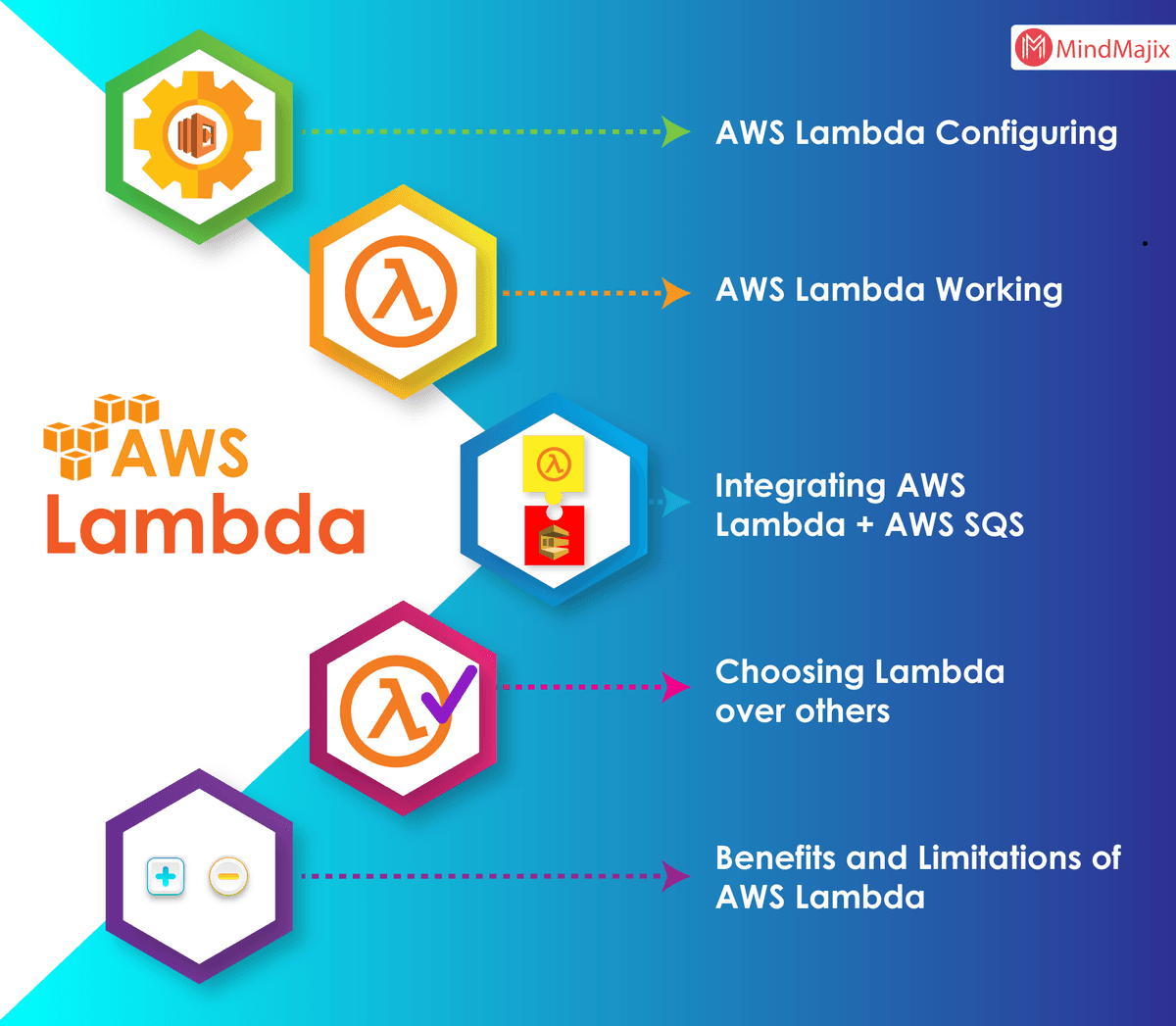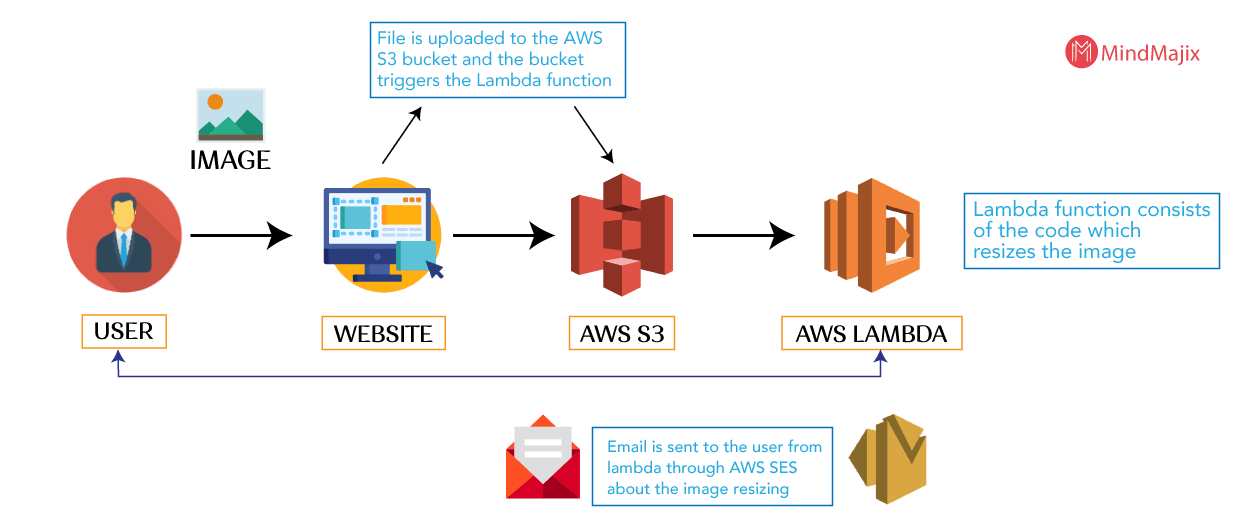- Introduction to Amazon Elastic File System
- Amazon On-Demand Instance Pricing
- AWS Kinesis
- Amazon Redshift Tutorial
- Amazon SageMaker - AIs Next Game Changer
- AWS Console - Amazon Web Services
- AWS Architect Interview Questions
- AWS Architecture
- Amazon Athena
- Top 11 AWS Certifications List and Exam Learning Path
- How to Create Alarms in Amazon CloudWatch
- AWS CloudWatch Tutorial
- Introduction To AWS CLI
- AWS Configuration
- AWS Data Pipeline Documentation
- AWS EC2 Instance Types
- AWS Elastic Beanstalk
- AWS Elastic Beanstalk Available in AWS GovCloud (US)
- AWS Free Tier Limits and Faq
- AWS EC2 Instance Pricing
- Choosing The Right EC2 Instance Type For Your Application
- AWS Interview Questions And Answers
- AWS Key Management Service
- AWS Lambda Interview Questions
- What Is AWS Management Console?
- Complete AWS Marketplace User Guide
- AWS Outage
- AWS Reserved Instances
- AWS SDK
- What is AWS SNS?
- AWS Simple Queue Service
- AWS SysOps Interview Questions
- AWS vs Azure
- AWS Vs Azure Vs Google Cloud Free Tier
- Introduction to AWS Pricing
- Brief Introduction to Amazon Web Services (AWS)
- Clean Up Process in AWS
- Creating a Custom AMI in AWS
- Creating an Elastic Load Balancer in AWS
- How to Deploy Your Web Application into AWS
- How to Launch Amazon EC2 Instance Using AMI?
- How to Launch Amazon EC2 Instances Using Auto Scaling
- How to Sign Up for the AWS Service?
- How to Update Your Amazon EC2 Security Group
- Process of Installing the Command Line Tools in AWS
- Big Data in AWS
- Earning Big Money With AWS Certification
- AWS Certification Without IT Experience. Is It Possible?
- How to deploy a Java enterprise application to AWS cloud
- What is AWS Lambda?
- Top 10 Reasons To Learn AWS
- Run a Controlled Deploy With AWS Elastic Beanstalk
- Apache Spark Clusters on Amazon EC2
- Top 30 AWS Services List in 2024
- What is Amazon S3? A Complete AWS S3 Tutorial
- What is AMI in AWS
- What is AWS? Amazon Web Services Introduction
- What is AWS Elasticsearch?
- What is AWS ELB? – A Complete AWS Load Balancer Tutorial
- What is AWS Glue?
- AWS IAM (Identity and Access Management)
- AWS IoT Core Tutorial - What is AWS IoT?
- What is Cloud Computing - Introduction to Cloud Computing
- Why AWS Has Gained Popularity?
- Top 10 Cloud Computing Tools
- AWS Glue Tutorial
- AWS Glue Interview Questions
- AWS S3 Interview Questions
- AWS Projects and Use Cases
- AWS VPC Interview Questions and Answers
- AWS EC2 Tutorial
- AWS VPC Tutorial
- AWS EC2 Interview Questions
- AWS DynamoDB Interview Questions
- AWS API Gateway Interview Questions
- How to Become a Big Data Engineer
- What is AWS Fargate?
- What is AWS CloudFront
- AWS CloudWatch Interview Questions
- What is AWS CloudFormation?
- What is AWS Cloudformation
- Cloud Computing Interview Questions
- What is AWS Batch
- What is AWS Amplify? - AWS Amplify Alternatives
- Types of Cloud Computing - Cloud Services
- AWS DevOps Tutorial - A Complete Guide
- What is AWS SageMaker - AWS SageMaker Tutorial
- Amazon Interview Questions
- AWS DevOps Interview Questions
- Cognizant Interview Questions
- Cognizant Genc Interview Questions
- Nutanix Interview Questions
- Cloud Computing Projects and Use Cases
- test info
Cloud computing is replacing server room hardware with virtual servers in the name of virtualization, a great strategy for provisioning, scaling, and adopting IT infrastructures according to changing requirements. What if we virtualize servers themselves out of existence? This is where AWS Lambda comes into the picture.
AWS Lambda is Amazon’s reliable serverless computing service to build applications. You should be curious why we prefer AWS Lambda while there are several computing services released by AWS. You can find the answer to this in this tutorial. Apart from that, you will learn to configure Lambda, work with Lambda, integrate AWS Lambda with AWS SQS, and finally the benefits and limitations of Lambda.
| In this AWS Lambda Tutorial, we will go through below topics |

AWS Lambda Tutorial for Beginners
What is AWS Lambda
AWS Lambda is a serverless cloud service that provides a new way to run event-driven applications as a service. It inspects actions within applications and through deploying, responds to the user-defined codes termed as functions. It manages the computing resources automatically across multiple availability zones and scales them when a new action triggers.
Where is Lambda used?
AWS Lambda runs the backend code by managing the AWS resources automatically. When we say ‘manage’, it includes launching or terminating instances, auto-scaling, health checkups, updating new updates, etc.
In a recent interview, Matt Wood, the chief product strategist at AWS said that AWS Lambda is the usher in the new era of cloud-based hosting and application development, and could be a replacement to Virtual Machines- one of Amazon’s core cloud services.
Most leading MNCs such as Netflix, NY Times, Conde Nast, and many more are migrating to serverless computing services. But, there are some situations where cloud architects get confused about serverless applications such as AWS Lambda and Azure Functions.
According to ServerlessConf's recent survey, one of the Cloud Gurus who currently uses AWS Lambda provided proof of serverless computing promise saying that they will never require to change the architecture due to issues in performance. The most shocking thing is that they were running 19 microservices with 3.68 TB of data and 287 Lambda functions at the mere cost of $580/month.
Now, let’s have a look at what is Serverless Compute
Serverless computing is a model of cloud-computing execution where the cloud provider runs the server and manages the machine resource allocations dynamically. The pricing depends on the number of consumed resources by an application instead of the pre-purchased capacity units. These applications don’t require any provisioning, maintaining, and servers to administer backend components, including database storage, compute, message queuing, stream processing, and more.
Amazon released Serverless computing architectures namely, PiCloud in 2010, which offers FaaS support for Python, AWS Lambda in 2014, the first cloud infrastructure vendor offering abstract serverless computing.
Why do we use AWS Lambda?
Using Lambda, you can virtually run an application code or any backend service without any administration costs. You just upload your application code, and Lambda will take care of the rest, i.e., executing and scaling your code with higher availability. It will enable you to set your code for automatically triggering from other AWS services or can call it directly from any web interface or a mobile app.
| Want to become a Certified AWS Solution Architect? Visit here to learn Amazon Web Services training |
How to Configure AWS Lambda
Follow these simple steps for configuring AWS Lambda.
Step 1 – Log in to your AWS account
Step 2 – In the services section, choose Lambda
Step 3 − Select any Blueprint (optional) and click on the Skip button
Step 4 − Provide all the details required for creating a function in Lambda as shown in the below screenshot and paste the code created using Node.JS, which will be automatically triggered whenever you add a new item in DynamoDB. Select all the required permissions.
Step 5 − Click on the Next icon and verify the details you provided.
Step 6 – Now, click on the Create Function button.
When you choose the Lambda service and click on the Event Sources tab, initially no record is found. Add one or more sources to the Lambda function to start working. Now, add a DynamoDB table to the function.
Step 7 – Choose the Stream tab and link it to the Lambda function.
Step 8 – Now, add some entries to the table. As soon as you start including entries into the table and save them, the Lambda service then triggers the function. This process is verified by the Lambda logs.
Step 9 – You can view logs at any time by selecting the Lambda service and then choosing the Monitoring tab. Finally, click on the View Logs in CloudWatch.
| Related Blog: AWS Configuration |
How AWS Lambda Works
To start working with AWS Lambda, you have to push the code into the Lambda service. All the other resources and tasks such as Operating System, Infrastructure, Server, code monitoring, security, and logs are managed by AWS.
A few essential aspects of Lambda-based application for a better understanding of Lambda working are listed below.
- Lambda Function: The libraries and custom codes that the user creates are known as Functions in Lambda.
- Event Source: Any AWS service that triggers the user-created function and helps in executing its logic.
- Log Streams: Lambda automatically monitors the functions and the user can view its metric on CloudWatch directly. You can even code your function that allows custom logging statements to analyze the workflow, performance, and to check whether it’s working correctly or not.
Example to illustrate the working of AWS Lambda:
Using AWS Lambda with S3
Let’s study working with AWS Lambda with an example of how AWS S3 can be implemented using AWS Lambda. Let’s consider that the user is uploading an image to the website and the function is resizing it.

Image illustrating How AWS Lambda performs tasks in the back-end.
Step 1: The user creates a Lambda function.
Step 2: The user uploads the Lambda function code.
Step 3: The next step is to upload the image from the website into the S3 bucket.
Step 4: After receiving the object(image), the S3 bucket will trigger the Lambda function.
Step 5: The Lambda Function starts working through image resizing in the back-end. At completion, it sends an email through SQS.
Integrating AWS Lambda with AWS SQS
Along with AWS Lambda, AWS SQS becomes pay-as-you-go, network access, and fully managed with no minimum commitments. AWS SQS is one of the most popular services used by thousands of customers. It is available at huge scales as one of the essential building blocks of several applications. Lambda supports all coding languages like Java, Node.js. Go, Python, and C++. Hence, it is flexible enough with fewer code-base changes.
Why Not Other Computing Services but Lambda
We all know that AWS Lambda is the best computing service provider by Amazon. If we talk about other AWS computing services to run a task like AWS Elastic Beanstalk or AWS EC2, why should we choose Lambda instead of them?
| Frequently Asked AWS Lambda Interview Questions |
Now let’s compare the three major Cloud Compute Services by AWS for a better understanding:
AWS EC2 VS AWS Lambda
| AWS Lambda | AWS EC2 |
| A PaaS (Platform as a Service) comes with a remote platform to execute the back-end code. | An IaaS (Infrastructure as a Service) comes with virtualized computing resources. |
| Not much flexible to log into compute instances, the user should choose customized O.S or language runtime. | Offers flexibility in choosing distinct instances, networks, operating systems, and security patches. |
| Had some environmental restrictions, as it manages a few languages. | No environmental restrictions are there. |
AWS Elastic Beanstalk VS AWS EC2
| AWS Beanstalk | AWS Lambda |
| Deploy and manage apps on AWS Cloud without any worry of infrastructure to run those applications. | Used only to run and execute back-end code, and can’t be used to deploy applications. |
| Provides freedom of selecting AWS resources such as choosing an optimal EC2 instance type to run your application. | No freedom to select your resources like EC2 instance types. Based on your workload, Lambda will provide resources. |
| It is a stateful system. | It’s a Stateless System. |
Benefits and Limitations of AWS Lambda
Benefits of AWS Lambda
- Continuous Scaling: Lambda scales the user applications automatically through running code in response to triggers. The user-generated code runs in parallel with the processes triggering individually, and scale precisely with the workload size.
- No Servers to Manage: AWS Lambda runs your code automatically without installing and managing servers. You can write code and upload it to Lambda.
- Subsecond Metering: The user will be charged only for every 10ms when your code executes and the number of times your code triggers.
- Unlike Amazon SWF activity types, no need to register Lambda tasks.
- You can use any existing functions of Lambda which you’ve defined already in workflows.
- Lambda functions are called by Amazon SWF directly, and there is no need to design.
- Amazon SWF directly calls the Lambda functions; no need to design programs to implement and execute them.
- Lambda provides metrics and logs to the users to track the functions under execution.
Limitations of AWS Lambda
Being the best Cloud Compute service provider, AWS Lambda has some limitations due to its hardware as well as architecture:
- The maximum duration to execute a request is set to only 300 seconds (5 minutes).
- In the case of hardware, the maximum disk space provided for a runtime environment is 512 MB, which is very little.
- The memory volume ranges between 128 and 1536 MB.
- The event request body can’t exceed 128 KB.
- The code execution timeout is set to 5 minutes only.
- The logs of Lambda functions are written only to CloudWatch, which is the only tool to monitor and troubleshoot the functions.
Conclusion:
Hence, in this AWS Lambda tutorial, we’ve studied AWS Lambda, its configuration, and its works. In addition, we also discussed the benefits and limitations of Lambda and its integration with SQS. I hope you enjoyed this dive into Lambda- the most craved knowledge area in the AWS ecosystem for various on-demand job positions including Solutions Architect, Cloud Engineer, DevOps Engineer, etc.
| Explore AWS Sample Resumes! Download & Edit, Get Noticed by Top Employers! |
List Of AWS Courses Offered By Mindmajix:
 On-Job Support Service
On-Job Support Service
Online Work Support for your on-job roles.

Our work-support plans provide precise options as per your project tasks. Whether you are a newbie or an experienced professional seeking assistance in completing project tasks, we are here with the following plans to meet your custom needs:
- Pay Per Hour
- Pay Per Week
- Monthly
| Name | Dates | |
|---|---|---|
| AWS Training | Jan 13 to Jan 28 | View Details |
| AWS Training | Jan 17 to Feb 01 | View Details |
| AWS Training | Jan 20 to Feb 04 | View Details |
| AWS Training | Jan 24 to Feb 08 | View Details |

Prasanthi is an expert writer in MongoDB, and has written for various reputable online and print publications. At present, she is working for MindMajix, and writes content not only on MongoDB, but also on Sharepoint, Uipath, and AWS.
















